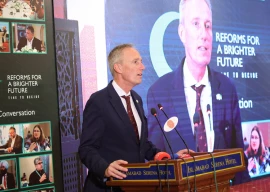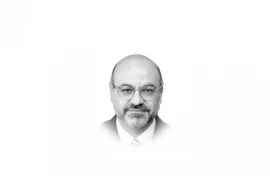
The caretaker set-up on Tuesday officially declared that the country’s economy contracted in the last fiscal year of the previous coalition government.
It also approved a provisional economic growth rate of 2.1% for the first quarter of the ongoing fiscal year.
The revised gross domestic product (GDP) estimates are now in line with Pakistan’s harsh ground realities, which also contradict the previous coalition government’s claim of achieving a growth rate of 0.3% in the fiscal year 2022-23, which ended in June.
The 107th meeting of the National Accounts Committee (NAC) held in Islamabad revised downwards the growth estimates for the fiscal year 2022-23 from an anemic growth of 0.3% to an economic contraction of 0.17%.
“The revised growth of GDP for the year 2022-23 is negative 0.17% against the provisional growth of 0.29%,” an NAC working paper read.
Pakistan’s population is increasing at a pace of 2.6% annually and any growth rate below this means that the country saw a surge in poverty, unemployment, and malnourishment.
The NAC also gave a nod to the provisional economic growth rate of 2.13% for July-September quarter of this fiscal year, making it the first such approval in almost a decade.
With this approval, the country has also met an important condition set by the International Monetary Fund (IMF) for giving quarterly economic growth figures before the end of November.
Planning and Development Secretary Awais Manzur Sumra chaired the 107th NAC meeting in which he revised the decisions made in the 106th huddle held in May this year.
The previous government had approved a provisional economic growth rate of 0.3% in the last fiscal year on back of severe restrictions imposed on the imports in an effort to avoid sovereign default, leaving the industries crippled with spillovers on the services sector.
However, independent economists, the World Bank and the IMF, had not accepted the 0.3% provisional growth.
The Express Tribune had reported in May that the then government pressured the Pakistan Bureau of Statistics (PBS) to cough up a nominal growth rate of 0.3% just to avoid the embarrassment of having a year of economic contraction on its hands.
The last fiscal year is now marked in Pakistan’s history as the one when the country had experienced devastating floods that washed away crops, highly mismanaged economy, and steep fall in the purchasing power of the people because of record inflation.
The previous government inflicted heavy losses on the economy by devaluing the rupee and increasing the utility prices in the hope of bagging a deal from the IMF.
In the end, neither the IMF programme could be revived, nor the economy saved from a disaster.
The economic growth rate during the last year of the PTI rule was also now revised upwards to 6.17%.
During 2017-2018 and 2021-2022, Pakistan’s growth was largely financed through foreign savings – a highly unsustainable method that led to a sovereign default-like situation.
Against the earlier estimate of attaining 1.6% growth rate, the agriculture sector growth rate is now adjusted upwards at 2.3% on the back of better production of wheat and maize in the last fiscal year.
The country had a bumper crop of 28.2 million tonnes of wheat production last year, according to the NAC statistics.
The NAC revised the sugarcane production downwards from 91 million tons to 88 million tons for the previous fiscal year.
Read Pakistan’s economy stuck in ‘low-growth trap’: WB
The livestock production was also slightly revised downwards by the NAC.
The NAC also further adjusted the contraction in the industrial sector, which has been worst hit by the previous government’s policies.
As against earlier estimates of a contraction of 2.94%, the government estimated that the decrease was as large as 3.8% in the industrial sector.
Earlier, the government had estimated that the large-scale industries contracted by 8% in the last fiscal year.
The NAC has now approved nearly 10% contraction in the sector, which is very crucial for jobs creation, high exports, and tax collection.
The government itself suffocated the industrial growth by placing curbs on imports that led to the shortage of raw materials and consequential closure of factories.
However, these curbs were necessary to avoid sovereign default.
The State Bank of Pakistan also increased the interest rates to a record 22% in the hope of containing inflation but it failed to do so.
In the process, the central bank massively increased the cost of debt servicing for the government and contributed to high unemployment in Pakistan.
The previous government had approved the services sector’s growth rate at nearly 1%, which at that time many had seen as an unrealistic figure.
The NAC has now revised the previous estimate downwards to an almost flat growth rate in the services sector, which has the largest share in the country’s national output.
The interim government has revised downwards the growth estimates for the transport sector. It has made a massive downwards revision in the air transport growth estimates.
The other major adjustment was made in the information and communication sector, which the last government had estimated growing by 7%. However, the interim government approved a negative growth of 2.6% for this sector.
The interim government also approved a provisional growth rate of 2.13% for July-September quarter of this fiscal year. This figure seems largely in line with Pakistan’s present economic conditions.
The quarterly economic growth rate is pulled up by the agriculture sector. This sector is estimated to have grown by 5.1% in the first quarter on the back of a healthy output and low base impact.
The NAC approved a 2.5% growth rate for the industrial sector -- up from the last quarter’s negative growth of 8.8%.
However, the services sector is estimated to have grown only by 0.8% -- still better than the previous quarter’s 2.3% contraction.
Overall, the NAC estimated that during the April-June quarter of the previous fiscal year, the economy contracted by 2.72% -- a trend that had been reversed in the first quarter of the ongoing one.
For the current fiscal year, the government has set a 3.5% economic growth target but the IMF has revised downwards its projection to 2% because of the prevailing financial crisis.



1730803801-0/BeFunky-collage-(22)1730803801-0-165x106.webp)

1728377970-0/Menendez-Brothers-(1)1728377970-0-165x106.webp)

1730799445-0/Untitled-design-(52)1730799445-0-270x192.webp)
1730800230-0/Copy-of-Untitled-(5)1730800230-0-270x192.webp)









1730706072-0/Copy-of-Untitled-(2)1730706072-0-270x192.webp)
COMMENTS
Comments are moderated and generally will be posted if they are on-topic and not abusive.
For more information, please see our Comments FAQ